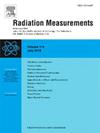Modeling the stochastic-deterministic boundary in luminescence: Consequences for dose estimation
IF 2.2
3区 物理与天体物理
Q2 NUCLEAR SCIENCE & TECHNOLOGY
引用次数: 0
Abstract
Kinetic models based on deterministic ordinary differential equations (ODEs) are effective for macroscopic systems, but a breakdown of their foundational assumptions is observed for single-grain and nanodosimetric applications where particle numbers are small. In this study, the metrological consequences of this stochastic-deterministic divergence are quantitatively investigated. The study's primary contribution is to deconvolve the divergence into two distinct components: a robust, inherent imprecision and a model-dependent, systematic inaccuracy. Intrinsic physical stochasticity is confirmed to be a dominant source of imprecision, generating an irreducible dose uncertainty of over 20 % that accounts for a significant fraction of single-grain overdispersion. Conversely, a systematic inaccuracy (e.g., a >50 % dose bias), initially observed in a simplified model, is demonstrated to be a methodological artifact, not a universal consequence of discreteness. It is shown that this systematic bias can be reduced to negligible levels (<1 %) by using either a more physically realistic multi-trap model or a correctly specified simple model. Based on this deconvolution, analytical protocols are assessed. An "Average-Dose-First" protocol is identified as the superior method, as it provides an accurate final dose estimate while correctly propagating measurement uncertainty. A general framework for understanding and partitioning variance in luminescence data is thereby established. Practical recommendations are provided for improving the accuracy of modern luminescence science by selecting appropriate models and using correct statistical protocols, with a strong emphasis on the critical need for model validation.
模拟发光的随机-确定性边界:剂量估计的后果
基于确定性常微分方程(ode)的动力学模型对宏观系统是有效的,但在颗粒数较小的单粒和纳米剂量学应用中,它们的基本假设被破坏了。在本研究中,定量研究了这种随机确定性发散的计量后果。这项研究的主要贡献是将这种差异解卷积为两个不同的组成部分:一个是强大的、固有的不精确性,另一个是依赖于模型的、系统的不精确性。固有的物理随机性被证实是不精确的主要来源,产生超过20%的不可减少的剂量不确定性,这占单粒过度分散的很大一部分。相反,最初在简化模型中观察到的系统性不准确性(例如,50%剂量偏差)被证明是方法学上的人为因素,而不是离散性的普遍后果。研究表明,通过使用更实际的多陷阱模型或正确指定的简单模型,这种系统偏差可以减少到可以忽略不计的水平(< 1%)。基于这种反褶积,分析方案被评估。“平均剂量优先”方案被认为是优越的方法,因为它在正确传播测量不确定度的同时提供了准确的最终剂量估计。从而建立了理解和划分发光数据方差的一般框架。通过选择合适的模型和使用正确的统计协议,为提高现代发光科学的准确性提供了实用的建议,并强调了对模型验证的迫切需要。
本文章由计算机程序翻译,如有差异,请以英文原文为准。
求助全文
约1分钟内获得全文
求助全文
来源期刊

Radiation Measurements
工程技术-核科学技术
CiteScore
4.10
自引率
20.00%
发文量
116
审稿时长
48 days
期刊介绍:
The journal seeks to publish papers that present advances in the following areas: spontaneous and stimulated luminescence (including scintillating materials, thermoluminescence, and optically stimulated luminescence); electron spin resonance of natural and synthetic materials; the physics, design and performance of radiation measurements (including computational modelling such as electronic transport simulations); the novel basic aspects of radiation measurement in medical physics. Studies of energy-transfer phenomena, track physics and microdosimetry are also of interest to the journal.
Applications relevant to the journal, particularly where they present novel detection techniques, novel analytical approaches or novel materials, include: personal dosimetry (including dosimetric quantities, active/electronic and passive monitoring techniques for photon, neutron and charged-particle exposures); environmental dosimetry (including methodological advances and predictive models related to radon, but generally excluding local survey results of radon where the main aim is to establish the radiation risk to populations); cosmic and high-energy radiation measurements (including dosimetry, space radiation effects, and single event upsets); dosimetry-based archaeological and Quaternary dating; dosimetry-based approaches to thermochronometry; accident and retrospective dosimetry (including activation detectors), and dosimetry and measurements related to medical applications.
 求助内容:
求助内容: 应助结果提醒方式:
应助结果提醒方式:


